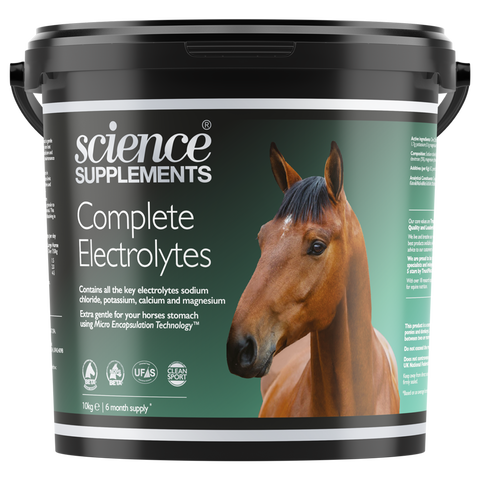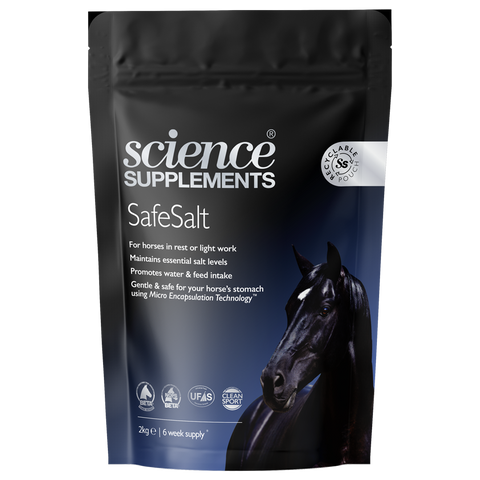Electrolytes are essential minerals found in the body, needed for hydration, blood acidity regulation, nutrient absorption, and nerve and muscle function. They are lost via sweat, urine, and breath, and so must be provided in the diet to ensure that deficiency does not occur. If you have ever looked at our Complete Electrolytes or SafeSalt, you might have read something about Micro Encapsulation Technology™. But what is this and why is it important?
Electrolyte uptake and absorption
Firstly, it is essential to understand how and where these electrolytes are absorbed in the horse. The five key electrolytes are sodium, chloride, potassium, calcium, and magnesium.
Most electrolytes are mixed into feed, fed using a syringe, or added to water. Once intake has occurred, the electrolytes travel through the gastrointestinal tract. They are then absorbed in the first section of the small intestine, called the duodenum, where uptake is optimal.
Before electrolytes reach the small intestine, however, they can start to break down and damage the stomach. Research has found that electrolyte and salt supplementation can increase the risk of gastric ulcer formation, or worsen them if a horse is already suffering. Imagine rubbing salt into an ulcer… ouch.
All it takes is a quick google, and there are pages and pages of anecdotes suggesting that table salt is the ‘best’ type of salt to feed your horse. Maybe these websites haven’t read the research.
The benefits of Micro Encapsulation Technology™
This is where Micro Encapsulation Technology™ comes in. A special oil coating covers the electrolytes, stopping them from dissolving in the mouth or stomach. They then dissolve entirely in the small intestine, where uptake is optimal, enabling the horse to maintain the correct electrolyte status. The oil coating also means that they do not cause any irritation to the stomach, so the risk of gastric ulceration is decreased and they are suitable for horses who may be prone to these issues.
Furthermore, micro encapsulation can enhance the palatability of electrolytes. Due to their granular texture, they are often left at the bottom of the feed manger. The oil coating provides a more palatable source of these electrolytes and helps overcome these potential problems.
Can’t I just feed electrolytes in water?
A lot of people opt to feed electrolytes in water, and whilst this does pose less risk to the stomach, there are still limitations. Firstly, the presentation of liquids with a novel taste or feel can be aversive to horses, and they may choose not to drink it. Horses can however be trained to drink it over time, and become used to the solution. Supplemented water should always be offered alongside pure water, and so it can be difficult to control and monitor electrolyte intake when the horse has a choice. The same goes for salt licks – they are a great boredom buster, but difficult to monitor. The benefit of adding electrolytes or salt to feed is that the intake is easier to control, and the horse is more likely to readily consume them.
Science Supplements are the first and only manufacturer to offer encapsulated supplements for horses, with the unique Micro Encapsulation Technology™ enabling horses to receive all of the electrolytes required, without any detrimental health consequences. To find out more about SafeSalt and Complete Electrolytes, click here.


References
Farina Alshut, Venner, M., Gunilla Martinsson, & Vervuert, I. (2023). The effects of feeding sodium chloride pellets on the gastric mucosa, acid‐base, and mineral status in exercising horses. Journal of Veterinary Internal Medicine, 37(6), 2552–2561. https://doi.org/10.1111/jvim.16851
Lindinger, M. I., & Ecker, G. L. (2012). Gastric emptying, intestinal absorption of electrolytes and exercise performance in electrolyte-supplemented horses. Experimental Physiology, 98(1), 193–206. https://doi.org/10.1113/expphysiol.2012.065185
Lindinger, M. (2022). Oral Electrolyte and Water Supplementation in Horses. Veterinary Sciences, 9(11), 626. https://doi.org/10.3390/vetsci9110626
Walker, W. T., Callan, R. J., Hill, A. E., & Tisher, K. B. (2014). Effects of oral powder electrolyte administration on packed cell volume, plasma chemistry parameters, and incidence of colic in horses participating in a 6-day 162-km trail ride. The Canadian veterinary journal = La revue veterinaire canadienne, 55(8), 765–771.
Waller, A. P., & Lindinger, M. I. (2021). Pre‐loading large volume oral electrolytes: tracing fluid and ion fluxes in horses during rest, exercise and recovery. The Journal of Physiology, 599(16), 3879–3896. https://doi.org/10.1113/jp281648
